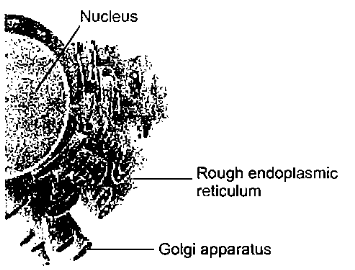Which of the following biomolecules is not the part of membrane?
(1)Nucleic Acid
(2)Proteins
(3)Lipids
(4)Carbohydrates
निम्नलिखित में से कौन सा जैवाणु, झिल्ली का भाग नहीं है?
(A) न्यूक्लिक अम्ल
(B) प्रोटीन
(C) लिपिड
(D) कार्बोहाइड्रेट
Eukaryotic cells considered as more efficient than prokaryotic cells, due to -
1. compartmentalisation of cytoplasm
2. Infolding of membrane
3. Presence of cell wall
4. Aerobic respiration
सुकेन्द्रकी कोशिकाओं को प्राककेंद्रकी कोशिकाओं की तुलना में अधिक दक्ष माना जाता है, किसके कारण -
1. कोशिकाद्रव्य का कोष्ठीकरण
2. झिल्ली का अंतबंलि
3. कोशिका भित्ति की उपस्थिति
4. वायवीय श्वसन
A cell organelle containing hydrolytic enzyme is
(1) lysosome
(2) microsome
(3) ribosome
(4) mesosome
जल अपघटनी एन्ज़ाइम युक्त कोशिका अंगक है:
(a) लयनकाय (b) सूक्ष्मकाय
(c) राइबोसोम (d) मध्यकाय
Cytoskeleton is made up of
1. calcium carbonate granules
2. callose deposits
3. cellulosic microfibrils
4. proteinaceous filaments
कोशिकीय कंकाल किससे बना होता है?
1. कैल्शियम कार्बोनेट कणिकाओं
2. कैलोस निक्षेप
3. सेलुलोसी सूक्ष्मतंतुक
4. प्रोटीनयुक्त तंतु
Which one; of the following organelle in the figure correctly matches with its function?

1. Rough endoplasmic reticulum, formation of glycoproteins
2. Golgi apparatus, protein synthesis
3. Golgi apparatus, formation of carbohydrates
4. Rough endoplasmic reticulum, protein synthesis
दिए गए चित्र में निम्लिखित में से कौन सा अंगक अपने कार्य से सही मेल खाता है? 
* Nucleus - केन्द्रक
* Rough endoplasmic - खुरदरी अंतः द्रवीय जालिका
* Golgi apparatus - गोलजी समिश्रण
1. खुरदरी अंतर्द्रव्यी जालिका, ग्लाइकोप्रोटीन का निर्माण
2. गॉल्जी उपकरण, प्रोटीन संश्लेषण
3. गॉल्जी उपकरण, कार्बोहाइड्रेट का निर्माण
4. खुरदरी अंतर्द्रव्यी जालिका, प्रोटीन संश्लेषण
Ribosomal RNA is actively synthesized in
1. lysosomes
2. nucleolus
3. nucleoplasm
4. ribosomes
राइबोसोमल आरएनए सक्रिय रूप से संश्लेषित होते हैं
1. लयनकाय में
2. केन्द्रिका में
3. केंद्रकद्रव्य में
4. राइबोसोम में
Which of the following organelles contain DNA?
(i) Mitochondria (ii) Chloroplasts (iii) Golgi bodies (iv) Ribosomes
(1) (i) and (ii)
(2) (ii) and (iii)
(3) (i) only
(4) (iv) only.
निम्नलिखित में से किस अंगक में डीएनए होता है?
(i) सूत्रकणिका (ii) हरितलवक (iii) गॉल्जी काय (iv) राइबोसोम
(a) (i) और (ii)
(b) (ii) और (iii)
(c) केवल (i)
(d) केवल (iv)
Who first explained that new cells are formed from pre-existing cells
1. Theodor Schwann
2. Rudolf Virchow
3. Matthias Schleiden
4. Robert Hooke
सर्वप्रथम किसने समझाया कि नई कोशिकाओं का निर्माण पूर्व स्थित कोशिकाओं से होता है:
1. थियोडोर श्वान
2. रुडोल्फ बिर्चो
3. मैथियस शील्डेन
4. रॉबर्ट हूक
Which of the following is true about chromosome
1. nucleoprotein
2. 23 pairs in single human diploid cell
3. Contains primary constriction
4. All of these
गुणसूत्र के विषय में निम्नलिखित में से कौन सा सही है?
(A) केंद्रकप्रोटीन
(B) एकल मानव द्विगुणित कोशिका में 23 युग्म
(C) प्राथमिक संकीर्णन सम्मिलित होता है
(D) ये सभी
Satellite body is formed in chromosome because of
(1)primary constriction
(2)secondary constriction
(3)Centromere
(4)Both A and C
उपाश्रित काय का निर्माण गुणसूत्र में किसके कारण होता है?
(A) प्राथमिक संकीर्णन
(B) द्वितीयक संकीर्णन
(C) गुणसूत्रबिंदु
(D) A और C दोनों






